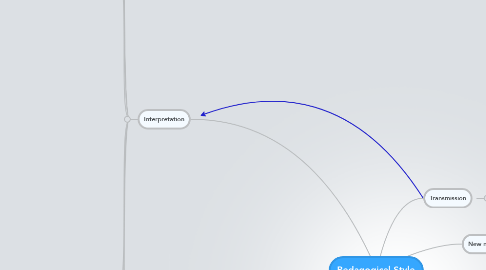
1. Interpretation
1.1. Implicit teaching
1.2. Learning in a social environment
1.3. More "hands-on"
1.4. Student centered
1.4.1. Vygotsky
1.4.1.1. ZPD (zone of proximal development)
1.4.1.2. MKO (more knowledgeable other)
1.4.2. Bruner
1.4.2.1. Collaborative learning
1.4.2.1.1. Exploratory/Process Talk
1.4.2.1.2. Joint construction of knowledge
1.4.2.2. Scaffolding
1.5. Lesson focused on developing listening skills
1.5.1. Aesthetic Listening
1.5.1.1. Listening for pleasure
1.5.1.1.1. Music
1.5.1.1.2. Story/poems
1.5.1.2. Response Theory
1.5.1.2.1. Reader-response classrooms promotes active learning
1.5.1.3. Structure
1.5.1.3.1. 1.Pre-listening
1.5.1.3.2. 2. During listening
1.5.1.3.3. 3. Post-listening
1.5.1.4. Upper primary
1.5.1.4.1. Read aloud
1.5.1.4.2. Interactive read aloud
1.5.1.4.3. DLTA
1.5.2. Efferent Listening
1.5.2.1. Listen to understand a message
1.5.2.1.1. Informational Text
1.5.2.2. Provide a language model
1.5.2.2.1. Expand knowledge
1.5.2.3. Strategies
1.5.2.3.1. Anticipation Guide
1.5.2.3.2. Organising
1.5.2.3.3. Summerising
1.5.2.3.4. Note-Taking
1.5.2.3.5. Monitoring
1.5.3. Critical Listening (Upper Primary)
1.5.3.1. Evaluate message
1.5.3.1.1. Debate
1.5.3.1.2. Discussion
1.5.4. Discriminative Listening
1.5.4.1. Distinguish Sound
1.5.4.1.1. Rhyming Words
1.6. The Different levels of listening Ability
1.6.1. Level 1: Receiving
1.6.2. Level 2: Auditory Discrimination
1.6.3. Level 3: Attending to a message
1.6.4. Level 4: Building efferent listening ability
1.6.5. Level 5: Becoming an active listener
1.6.6. Level 6: Listening appreciatively and reflectively
1.7. Linking speaking and listening through theories of input and output
1.7.1. Input
1.7.1.1. What the teachers wants the pupils to learn
1.7.2. Intake
1.7.2.1. What the pupils actually learn
1.7.3. Output
1.7.4. Strategies for supporting language development
1.7.4.1. Expansions
1.7.4.2. Extension
1.7.4.3. Repetition
1.7.4.4. Parallel Talk
1.7.4.5. Self-talk
1.7.4.6. Vertical structuring
1.7.4.7. Fill-ins
1.8. Mode Continuum
1.8.1. Literacy
1.8.1.1. Reading
1.8.1.2. Writing
1.8.2. Productive
1.8.2.1. Speaking
1.8.2.2. Writing
1.8.3. Oracy
1.8.3.1. Listening
1.8.3.2. Speaking
1.8.3.2.1. Informal face to face chat
1.8.4. Receptive
1.8.4.1. Reading
1.8.4.1.1. Reading aloud
1.8.4.2. Listening
2. New node
3. Transmission
3.1. Explicit teaching
3.2. Rote Learning
3.3. Teacher directed
3.3.1. Students are passive
3.3.1.1. Empty Vessels?
